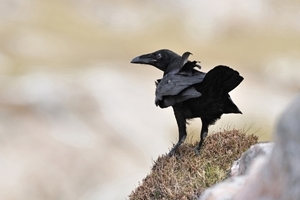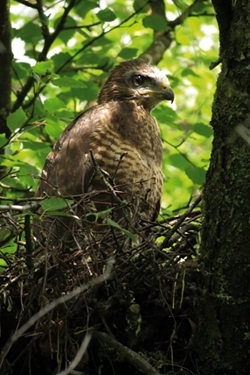Key points
- Management of heather moorland for driven red grouse shooting may benefit some raptors and ravens by reducing the risk of predation and increasing food availability.
- Between 1992 and 2018, numbers and breeding success of four raptor species and raven were monitored on Langholm Moor in southwest Scotland.
- Ground-nesting raptors (hen harrier and merlin) increased when the moor was managed for grouse, and had a higher proportion of successful breeding attempts. In contrast, changes in grouse moor management did not influence numbers or breeding success of tree- or crag-nesting species (peregrine, buzzard and raven).
- This study highlights that grouse moor management can benefit ground-nesting raptors like hen harrier and merlin. However, at the national scale these benefits to hen harriers are currently outweighed by illegal killing.
Background
 Large areas of heather moorland in the UK are managed for shooting red grouse. Grouse moor management includes burning or cutting heather and legally controlling generalist predators (e.g. red foxes and carrion crows), which increases numbers of red grouse as well as other ground-nesting birds such as waders and some passerines.
Large areas of heather moorland in the UK are managed for shooting red grouse. Grouse moor management includes burning or cutting heather and legally controlling generalist predators (e.g. red foxes and carrion crows), which increases numbers of red grouse as well as other ground-nesting birds such as waders and some passerines.
Some raptors may also benefit from this management because it both lowers the risk of predation and increases their food supply. Nest predation can be an important cause of breeding failure, with nests on the ground being more vulnerable to mammalian predators, such as foxes, than those in trees or on other elevated structures. However, driven grouse moors have also been associated with the illegal killing of raptors that predate grouse, for example hen harrier and peregrine. Hence, previous studies found that hen harriers had lower survival and breeding success on grouse moors compared to other heather-dominated moors.
In this study, the authors described changes in abundance and breeding success of ground-nesting raptors (hen harrier and merlin), tree- or crag-nesting raptors (peregrine and buzzard) and raven on a grouse moor in southwest Scotland, where these species were fully protected in accordance with the law.
Photo credit: Laurie Campbell
What did they do?
The 27-year study took place on Langholm Moor in southwest Scotland between 1992 and 2018. Langholm Moor is dominated by heather and grass moorland, and includes a Special Protection Area (SPA) for breeding hen harriers.
Over the course of the study, Langholm Moor has seen a succession of managed and unmanaged periods:
- Managed: In 1992-1999 and 2008-2016, Langholm Moor was managed for red grouse. During these periods, full-time gamekeepers were employed to carry out predator control and heather management. For some of these years, management also included diversionary feeding of hen harriers and treating grouse for intestinal parasites.
- Unmanaged: In 2000-2007 and 2017-2018, no full-time gamekeepers were employed on Langholm Moor.
The authors recorded the number of breeding hen harrier, merlin, peregrine, buzzards and raven throughout the study period (although data were not available for all species in all years). Wherever possible, breeding attempts were monitored from the time eggs were laid until chicks fledged to determine their outcome. A nest was considered successful if at least one chick was fledged. For unsuccessful breeding attempts of hen harrier and merlin, field signs at the nest were used to identify the likely cause of failure, e.g. remains of eggshells or chicks. This was complemented with nest camera footage for harriers. Where eggs or chicks disappeared without signs, nests were assumed to have been predated by an unknown predator.
To assess whether changes in raptor numbers or breeding success were associated with changes in prey availability, the authors also estimated the abundance of small moorland birds, field voles, and red grouse. Small moorland birds (meadow pipits and skylarks) were counted each year during breeding bird surveys in mid-May to mid-June, and field vole abundance was estimated through snap-trapping in late March to early April. Red grouse were counted in March and July using pointing dogs to estimate density of adult grouse in spring and density of grouse chicks in July.
The authors then tested whether trends in numbers or breeding success of raptors and raven were different between managed and unmanaged periods, and whether these changes were associated with changes in the availability of their prey.
What did they find?
Red grouse density was higher when Langholm Moor was managed for red grouse. However, the abundance of small moorland birds and field voles did not change.
Breeding success of ground-nesting species, hen harrier and merlin, was 2-3 times higher when the moor was managed for grouse. This was not related to changes in prey availability, but to changes in nest predation rates, which was the main cause of apparent breeding failure in this study. Hen harrier numbers increased during both managed periods, but declined when the moor was unmanaged. Merlin numbers increased during the second managed period, but not the first, and remained low in the unmanaged period in between.
In contrast, grouse moor management did not significantly affect the numbers or breeding success of tree- or crag-nesting species (peregrine, buzzard, and raven). Over the course of the study, peregrine and raven showed little change in numbers, while buzzard numbers increased in line with regional and national trends.
What does this mean?
 This study highlights that grouse moor management can benefit ground-nesting raptors such as hen harrier and merlin, mainly by reducing the risk of nest predation, which increased breeding success. In contrast, grouse moor management had no significant effect on tree- or crag-nesting species, whose eggs and chicks are less accessible to mammalian predators. Peregrine, buzzard and raven also have broader diets compared to hen harrier and merlin, so are less reliant on specific prey species such as grouse, small birds, or voles.
This study highlights that grouse moor management can benefit ground-nesting raptors such as hen harrier and merlin, mainly by reducing the risk of nest predation, which increased breeding success. In contrast, grouse moor management had no significant effect on tree- or crag-nesting species, whose eggs and chicks are less accessible to mammalian predators. Peregrine, buzzard and raven also have broader diets compared to hen harrier and merlin, so are less reliant on specific prey species such as grouse, small birds, or voles.
However, at a national scale the benefits of grouse moor management for hen harrier are currently outweighed by their illegal killing. On the other hand, the results of this study showed that stopping grouse moor management was associated with declines in hen harrier and merlin breeding success as well as declines in hen harrier numbers. If the impact of hen harriers on grouse could be reduced, it might be possible to improve their conservation status while maintaining driven shooting.
About the LMDP
This study was part of the Langholm Moor Demonstration Project, a long-running collaboration between the GWCT, SNH, Buccleuch Estates, the RSPB and Natural England, which aimed to resolve the conflict between driven grouse shooting and raptor conservation. Further papers from the Langholm Moor Demonstration Project can be found on the LMDP website.
Read the original paper
Ludwig, S.C., Roos, S., Rollie, C.J., Baines, D. (2020) Long-term changes in the abundance and breeding success of raptors and raven in periods of varying management of a Scottish grouse moor. Avian Conservation and Ecology 15 (1), 21.